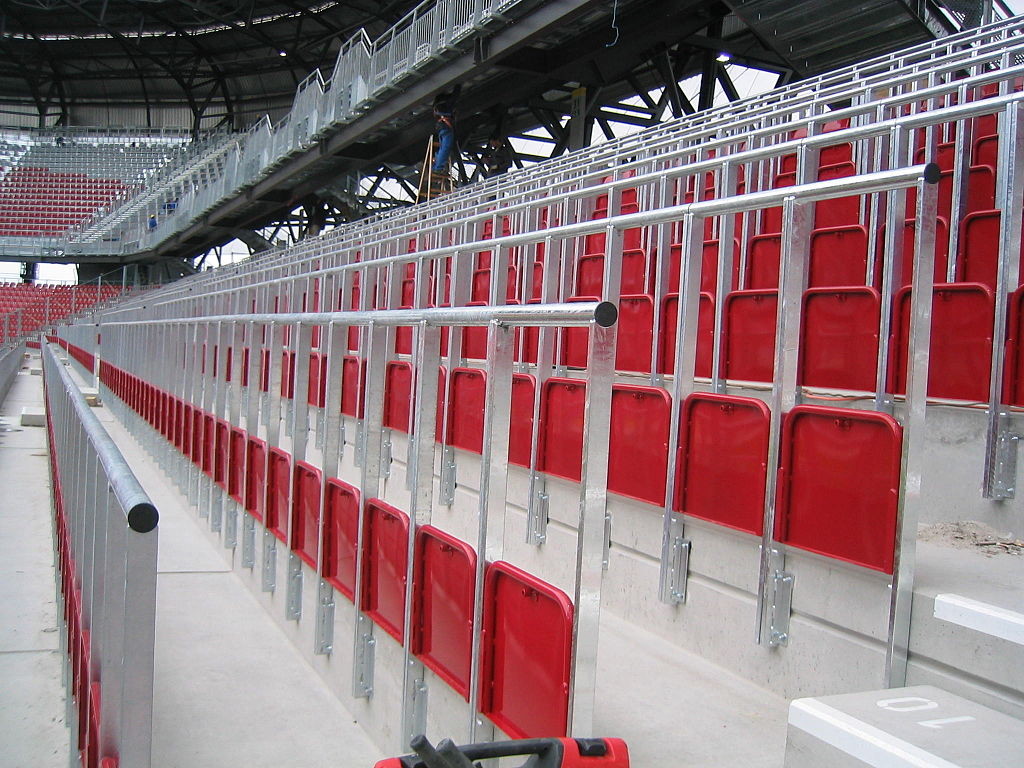The U.K. government refuses to change its stance on “safe standing” sections at stadiums although fans and some teams strongly support the idea.
Nearly half of all football (soccer) clubs in Germany have safe standing sections in their venue as it increases attendance, adds to the atmosphere, and helps keep ticket prices down. For example, Bayern Munich’s (Germany) most affordable season ticket costs £150 while Arsenal’s (England) most affordable season ticket costs £1,014.
Why is the U.K. against “safe standing?” As seen in this ESPN 30 for 30, the Hillsborough disaster of 1989 left 96 fans dead from a crush in a “safe standing” section. New initiatives have been developed to prevent a similar disaster, such as every row having a rail compared to Hillsborough where a rail was placed in every 10 rows or so. However, the U.K. government is still highly reluctant to approve “safe standing.”

The Stretford End terrace prior to renovations in 1993. Notice the old version of safe standing in the supporters’ section.
We’d love to hear from our members about this. Do any of our venues in the U.S. or Canada have “safe standing” sections? Would you consider adding a “safe standing” section to your venue? Why or why not?
(Image: Jon Darch/Creative Commons)


The safe standing debate isn’t as cut and dry as comparing the conditions within German and English stadiums, wider issues associated with standing bays need to be considered.
As stadium managers our number one concern should always be patron safety, we have a duty of care to provide a safe environment for all fans regardless of the desires to recreate the atmosphere of yesteryear. While serge rails have been proposed to avoid crushes such as Hillsborough, issues such as bay capacities and final exit widths must also be considered to ensure patrons can escape to a place of safety within a designated time to avoid the loss of life experiences at Bradford.
I would seriously debate that safe standing reduces the cost of a football ticket, in fact considering the fixed environment of a football stadium and the challenge of increasing bay exit width for emergency egress, there is little opportunity to introduce additional capacity within existing grounds. Given anti-social fan behaviour associated with standing crowds in UK football I would argue the costs of stewarding and monitoring these bays would be significantly higher when compared with fully seated bays.
Managing crowd safety at high risk events is an incredibly difficult and challenging task and when the time comes to eject a patron from the stands in a highly energetic environment it is infinitely easier to do so from a seated stand. Monitoring crowd behaviour and identifying problem patrons before they harm or disrupt the event for those around them is one of the primary roles of Crowd Safety Managers. The introduction of standing areas only makes this task more difficult as the ability to manage, monitor and move through the bay is heavily restricted due to the increased density of the dynamic nature of crowd.
Other factors that should be considered is the fan experience and their ability to enjoy the event. As we know patrons come in different shapes and sizes and the assumption that all with a safe standing bay will be able to view the event can be a dangerous one. Stadium Managers have an obligation to ensure patrons who have purchased a ticket have the ability to see the event and while seated bays still have this challenge it significantly reduced when compared with that of standing areas.
Many could argue that the new design of standing bays are safer than concert mosh pits and to a degree they would be correct if these were designed to consider safe evacuation and holding pressures. However the main difference remains that a mosh pit capacities are calculated to meet three main factors, loading time, density ratio and exit width, with the lower of these three factors assumed to be the maximum pit capacity. Having room for patrons to move into and dissipate serge pressures is a key safety factor in densely populated areas, this is a luxury which is not readily available in the fixed structures of existing stadia stands.
The management of our stadiums has moved on significantly in the past 20 years and the lessons learnt of past disasters which have been built into the design, operational procedures and legislative obligations of modern stadia have created an infinitely safer environment. Stadium Managers first and foremost must consider patron safety and unless safe standing is a feature of the initial stadium design to compensate for bay overcrowding and safe egress it is incredibly difficulty to retrospectively introduce into the fixed environment of existing stadia.